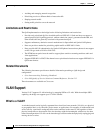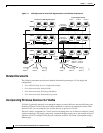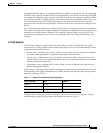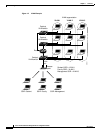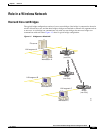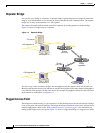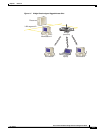
1-7
Cisco Aironet 350 Series Bridge Software Configuration Guide
OL-1410-07
Chapter 1 Overview
VLAN Support
In fundamental terms, the key to configuring an bridge to connect to a specific VLAN is by configuring
an SSID to map to that VLAN. Because VLANs are identified by a VLAN ID, it follows that if an SSID
on an bridge is configured to mapto a specific VLAN ID, a connection to the VLAN is established. When
this connection is made, associated wireless client devices having the same SSID are able to access the
VLAN through the bridge. The VLAN processes data to and from the clients the same way that it
processes data to and from wired connections. The fact that the client is wireless has no impact on the
VLAN.
The VLAN feature now enables users to deploy wireless devices with greater efficiency and flexibility.
For example, onebridge can now handle the specific requirements of multiple usershaving widely varied
network access and permissions. Without VLAN capability, multiple bridges, one for each VLAN,
would have to be employed to serve classes of users based on the access and permissions they were
assigned.
A VLAN Example
The following simplified example shows how wireless devices can be used effectively in a VLAN
environment on a college campus. In this example, three levels of access are available through VLANs
configured on the physical network:
• Student access—Lowest level of access; ability to access school’s Intranet, obtain class schedules
and grades, make appointments, and perform other student-related activities
• Faculty access—Medium level of access; ability to access internal files, read to and write from
student databases, access the intranet and Internet, and access internal information such as human
resources and payroll information
• Management access—Highest level of access; ability to access all internal drives and files, and
perform management activities
In this scenario, a minimum of three VLAN connections would be required: one for each level of access
discussed above. The bridge can handle up to 16 SSIDs; therefore, the following basic design could be
employed as shown in Table 1-1.
Using this design, setting up the clients is based on the level of access each user requires. A typical
network diagram using this design would look like the one shown in Figure 1-2.
Table 1-1 Access Level SSID and VLAN Assignment
Level of Access SSID VLAN ID
Student Student 01
Faculty Faculty 02
Management Management 03






